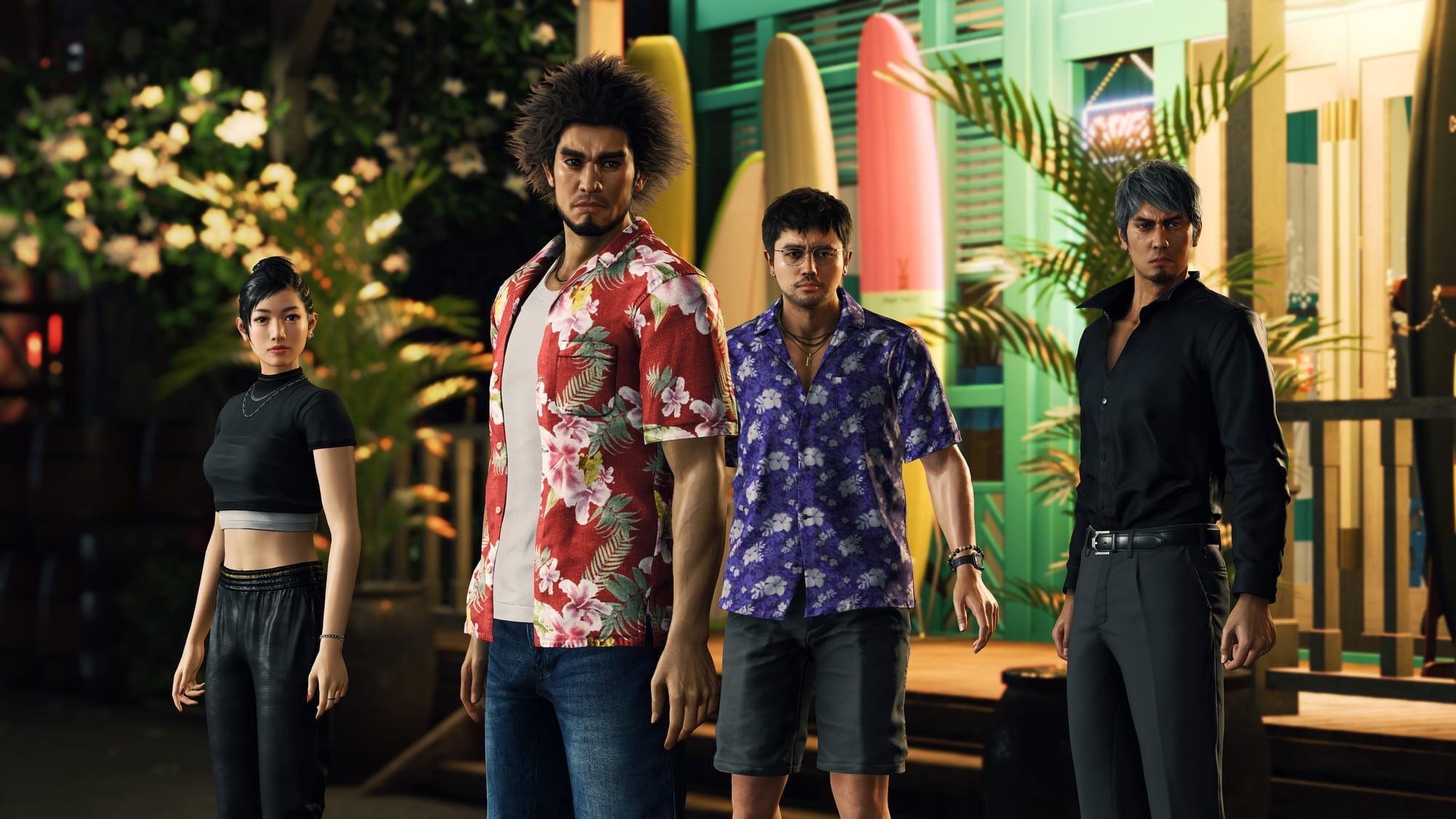Like a Dragon: Infinite Wealth – A Hero’s Game, a Dragon’s Story
Introspection in retrospect

Like a Dragon: Infinite Wealth may have been a game of two heroes: current headliner Ichiban Kasuga and longtime mainstay Kazuma Kiryu. In a sense, the game represents a daring step in Kasuga’s adventure album; it takes him all the way to Hawaii complete with its sun-soaked locale, colorful culture, and conversely, the sinister underbelly beneath its paradise. However, a look through Kiryu’s side of the story reveals a trip down memory lane for the legendary character, one that treads a path initially set by its immediate predecessor, Like a Dragon Gaiden: The Man Who Erased His Name.

During his misadventures in Hawaii, Kasuga encounters an aging Kiryu, the first time the two characters meet since Yakuza: Like a Dragon. Kiryu immediately joins Kasuga in his journey, where the duo finds new allies while encountering no small number of unruly personalities and less-than-upstanding citizens during their adventure.
![[bf]Like a Dragon: Infinite Wealth – A Hero’s Game, a Dragon’s Story](https://www.superjumpmagazine.com/content/images/size/w2000/2024/03/Like-a-Dragon-Infinite-Wealth---Horizontal.jpg)
However, it is revealed early in the game that Kiryu has been suffering from lung cancer and has approximately six months left to live. Despite Kasuga’s protests, Kiryu insists on helping Kasuga, which, after an incident, culminated in him being forced to return to Japan to resume treatment. Once he touches down at Isezaki Ijincho, Yokohama, Kiryu embarks on a separate journey where he teams up with some of Kasuga’s party members in Yakuza: Like a Dragon.
Regardless, Kiryu still assists Kasuga’s journey and gives him advice remotely from time to time. On the other hand, his acute condition also forced him to confront a new enemy: his mortality.
As a result, Kiryu’s side content is more focused on him rekindling memories he had accumulated from past Yakuza entries, in the form of an in-game feature called the ‘Bucket List’. The Bucket List has three activities to partake in, one of which is called ‘Unfinished Business’, where Kiryu can increase his base stats by completing a checklist of in-game activities such as battles and mini-games.
The other two are more closely tied to Kiryu’s past life and in a sense, the player’s past experiences. There is ‘Memoirs of the Dragon’ that enables Kiryu to reminisce about an event, an individual, a place, or even an in-game feature by interacting with a glowing point of interest. Almost everything players have come to know and love about the Like a Dragon series comes into play here, from the ever-reliable Staminan energy drinks to the Millennium Tower, where Like a Dragon boss battles happen every other week.
Another aspect of Memoirs is allowing Kiryu to interact with characters from his past via the game’s side mission system. The relevance of these characters to Kiryu’s journey varies; some play sizeable roles, and others don’t even know he was an ex-Yakuza. Kiryu’s interactions with these characters also vary in tone; some are wholesome, others intense, but all feature a common sentiment: an underlying sense of nostalgia. These people were part of Kiryu’s past adventures, and this aspect of Memoirs allows players to tap into how Kiryu felt about their presence in his story.

Then there are characters, found in a section called ‘Life Links’, with much bigger roles in Kiryu’s journey that require a more intimate sense of reflection, both from Kiryu and themselves. Life Links can be unlocked as the story progresses, and by reaching a certain overall level with Kiryu’s base stats.
Life Links allow Kiryu to interact with major players of his past adventures, although only indirectly due to his arrangement with the Daidoji faction. From one-off deuteragonists to characters that appear in ALL Like a Dragon games prior to Yakuza: Like a Dragon, these Life Links serve as a way to catch up on what these characters have been doing. Additionally, Life Links also acts like the game’s ‘interview’ with these characters on what they think of Kiryu as a person. Their appearances can act as a reunion for players as much as they are for Kiryu. Some of them haven’t made an appearance since their debut games, more than a decade ago in some cases.
This might be the first time a Like a Dragon game has put a large emotional focus on a character through its side content. While the series’ side content has never shied away from emotional moments, rarely has it done so with a thorough, hours-long exploration of its protagonist’s mythos.
On the other hand, let's look at Kasuga’s side content. ‘Sicko Snap’ has him taking pictures of exhibitionists from a trolley. ‘Sujimon League’ has Kasuga battle to the top of a pseudo-Pokémon league with degenerates in place of pocket monsters. ‘Dondoko Island’ sees Kasuga refurbishing a defunct island resort, Animal Crossing-style. Lastly, Kasuga’s side missions are sometimes wholesome and sometimes extremely ridiculous. While not shallow emotionally (hint: look for the old man tossing shaved ice around), most of Kasuga’s side content is undeniably sunshine and rainbows. The ‘fun’ part—what defines a game—is reserved for Kasuga’s side of Hawaii.

This might be the first time a Like a Dragon game has put a large emotional focus on a character through its side content. While the series’ side content has never shied away from emotional moments, rarely has it done so with a thorough, hours-long exploration of its protagonist’s mythos.
Conversely, all of Kiryu’s side content is personal or introspective in one way or another. Sometimes, this introspective nature bleeds into Kiryu’s part of the main narrative. At times, the main story takes a moment to reflect on Kiryu’s struggles and battles throughout the years, and the people he has met along the way. Even with Kasuga’s party who have never interacted with him properly before, players are able to see how those experiences measure up to new people in his life, and how his strength and ideals, despite his waning physical prowess, inspire those around him.
As mentioned before, players learn what these people think of him, be it in a candid or premeditated manner. Players learn how he has affected their lives, even when he has long disappeared from them. Playing through Life Links, much like Memoirs, reveals a profound fact: even though the lives of these characters march on, Kazuma Kiryu stays in their memories forever.
But at the same time, players can finally see Kiryu’s accumulated opinions on his own life as well. We see how these encounters shaped Kiryu as a person, but we also see how these encounters shaped the players’ varying degrees of experience with the game series. Some players only have a limited experience of the games, and thus are only able to resonate with some of the Memoirs’ items. Others have experienced all the series have to offer, and thus are able to relate to all aspects of the Memoirs. Nevertheless, these callbacks ensure that no matter how limited or all-encompassing the exposure, it’s still an important part of Kiryu’s story—and to an extent, the players’.
These features make Infinite Wealth feel like a much deeper retrospective of Kiryu’s character, even more so than Like a Dragon Gaiden. If Like a Dragon Gaiden felt like a farewell letter to Kazuma Kiryu, then Infinite Wealth felt like a last drink together with the man; a time when players get to laugh, cry, and remember all the good times they’ve had with the character, how their journey together has shaped each other in different—but nonetheless meaningful—ways.

These features make Infinite Wealth feel like a much deeper retrospective of Kiryu’s character, even more so than Like a Dragon Gaiden.
In some ways, Infinite Wealth reminds me of Yakuza 0, coincidentally the last time RGG Studios made a Like a Dragon game with a dual protagonist format. Yakuza 0 in some ways felt like Kiryu’s game; he had been the main hero of the series up until that point, and the game starts from his point of view. However, once Goro Majima came into the fold, it became clear that the game’s story was shaped around his narrative. As the story progresses, players get to see how he got involved with the game’s main conflict, as well as how he developed his own personal stakes for the game’s storyline, arguably bigger than Kiryu’s. In the end, thanks to his scene-stealing narrative, players were left enamored with the origin story of Goro Majima, the Mad Dog of Shimano.
Yakuza 0 is Kiryu’s game but tells Majima’s story. Infinite Wealth is Kasuga’s game but tells Kiryu’s story. The main difference is that Majima’s story is prospective, while Kiryu’s story is retrospective.
There is no denying that I enjoyed Kasuga’s escapades in Hawaii—a lot. However, I can't deny that Kiryu’s journey made a bigger impact on me.
But rather than holding spite over less Kiryu and more Kasuga in the future, I am elated to have seen the two heroes properly meet and team up in a scenario where they learn from each other. It is a proper passing of the torch; a more impactful one compared to Yakuza: Like a Dragon. In turn, Infinite Wealth gives me more confidence for upcoming Ichiban Kasuga adventures, while also giving me more closure with the series’ soon-to-come farewell with the legendary Kazuma Kiryu.
